Raspberry Varieties and Their Infestation by Drosophila suzukii
One of the major insect pests which attack raspberry plants during their fruiting time is the invasive fly species, the spotted wing drosophila (SWD), Drosophila suzukii. The female fly attacks undamaged (unlike other Drosophila species) ripening fruit; it lays eggs under the skin of the fruit, and emerging maggots feed inside the fruit making them unmarketable.
Some of the raspberry varieties, however, can minimize or even avoid the infestation by SWD. How and which raspberry varieties can potentially limit the risk of being attacked by the SWD? From a plant perspective, the key to success would be to fruit when pests are not yet present, a strategy known as phenological resistance. Here we talk about the main raspberry varieties and discuss the examples from recent studies on how development of raspberry plants may or may not match the seasonal occurrence of the spotted wing drosophila.
Raspberry plants can live many years, but only the root system and the crown are actually perennial. The individual shoots (canes), however, are biennial which means that they may live only two years. With regards to fruiting such canes can differ in different raspberry varieties; as a result, we can see raspberry plants fruiting either early in summer (summer-bearing raspberries), or in fall (fall-bearing raspberries).
In the summer-bearing raspberries, the canes of the first year (called primocanes) show up early in spring and have only vegetative growth during the first year. On the second year, primocanes (now called floricanes) have flowers and then fruit early in the summer season. In the fall-bearing raspberries, however, primocanes have fruit during the first fall season. On the second year, primocanes continue to have fruit usually until mid-summer, and then they die (Fig. 1 and Table 1).

In terms of crop yield the fall-bearing raspberries have some advantages over the summer-bearing raspberries, by adding six weeks or more to the fruit season (Pritts, 2008). However, those additional weeks of fruiting might coincide with high infestation of raspberry plants by SWD. For example, it was observed that in Wisconsin the first flies can be detected as early as mid-June; the fly population builds up from late June/early July with the population peak in late August/early September; and then populations gradually decrease during the Fall (Table 2).

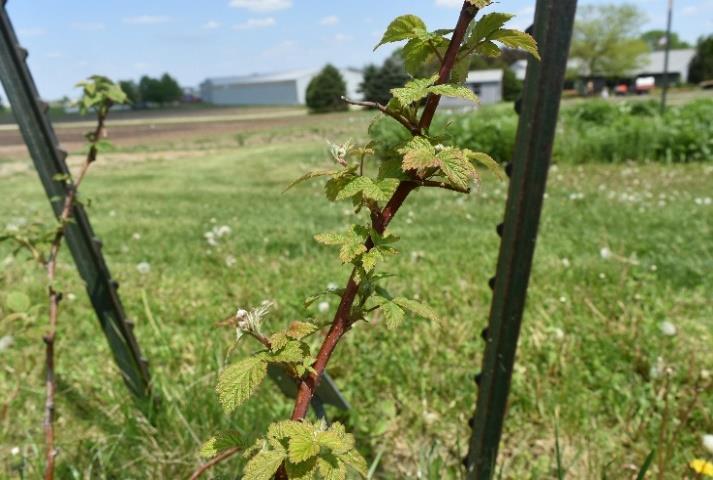
Floricane,
Summer raspberry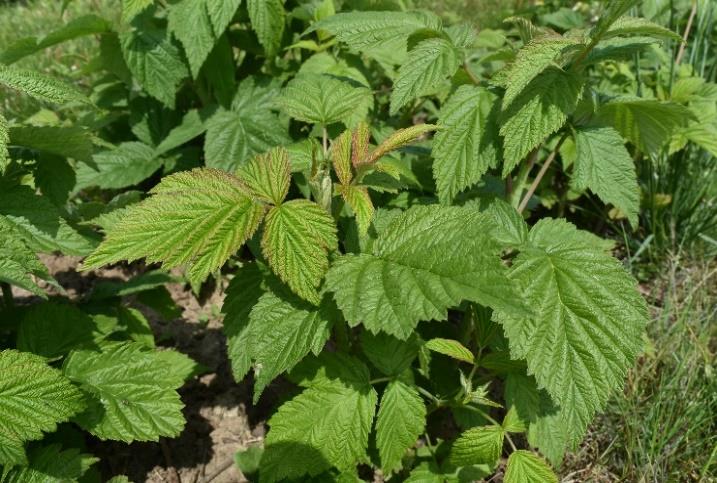
Primocane,
Fall raspberry
Var. ‘Polana’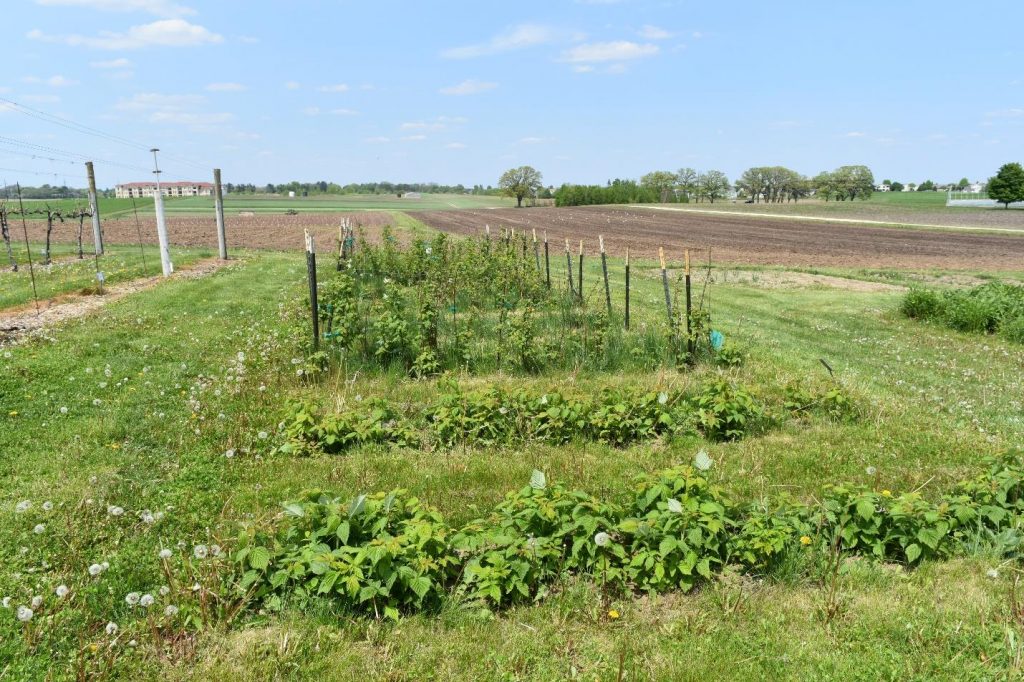
Summer raspberry varieties and Fall raspberry varieties
Even though all raspberries might be susceptible to SWD, different varieties of summer raspberries and fall raspberries still can have different infestation rate. For example, Burrack et al. (2013) compared the SWD larvae infestation rates in the field across different commonly grown raspberry varieties in the southeastern US. They found that although none of the varieties escaped infestation, some varieties such as floricane-bearing ‘var. NC 344’ and primocane-bearing ‘Nantahala’ had lower infestation rates (Table 3). At the same time, some summer (floricane-bearing) raspberry varieties might not differ in the SWD infestation (Lee et al., 2011; Table 3).
Although some raspberry varieties can be more preferable for the SWD than others the overall tendency is that summer-bearing raspberries have limited risk for SWD and fall-bearing raspberries are more vulnerable with potentially heavy infestation in August-September. Phenological resistance of raspberry to SWD is still being explored, and here is the example of what we might observe when the plant harvest does or doesn’t coincide with establishing of SWD population (Fig.2; blueberry plants). Another good example of phenological resistance is strawberry plants which avoid SWD infestation due to early fruiting.
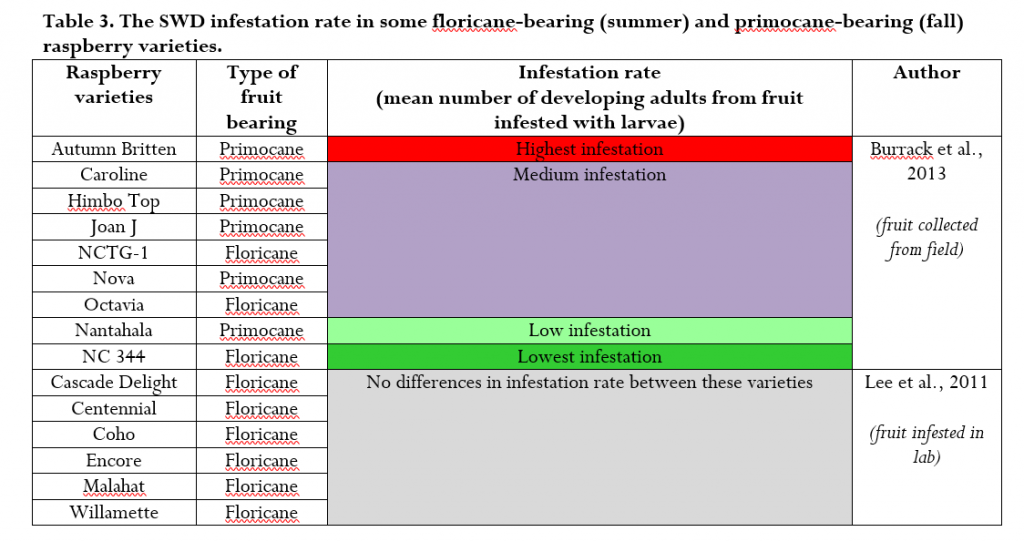
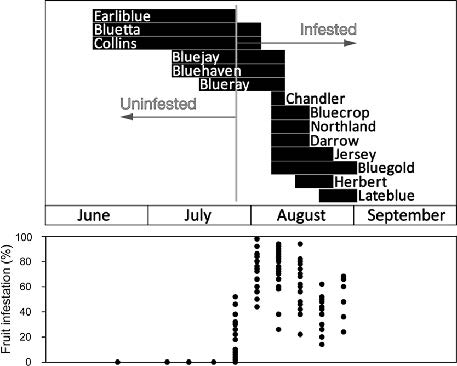
There are several potential factors which can affect the accessibility of raspberry varieties for SWD and which might explain why some varieties are infested more than others. Such factors can include penetration force (most likely the key factor), yield and fruit size (Burrack et al., 2013). It was observed that the flies prefer berries which are easier to penetrate and which are smaller; while no differences in fly infestation among lower-yielding and higher-yielding varieties have been detected (Burrack et al., 2013).
Considering all those differences in raspberry plants which we discussed above, we recommend planting early-fruiting (summer-bearing) varieties. This would provide additional protection to the plants from SWD infestation through the mechanisms of phenological resistance. As a result, such early-fruiting varieties might minimize risk from SWD or even completely avoid fruit infestation by SWD.
References:
Barney, D. L. et. al (2007). Commercial red raspberry production in the Pacific Northwest. [Corvallis, Or.]: Oregon State University Extension Service;[Moscow, Idaho]: University of Idaho Cooperative Extension System;[Pullman, Wash.]: Washington State University Extension;[Washington, DC]: US Dept. of Agriculture.
Burrack, H. J., Fernandez, G. E., Spivey, T., & Kraus, D. A. (2013). Variation in selection and utilization of host crops in the field and laboratory by Drosophila suzukii Matsumara (Diptera: Drosophilidae), an invasive frugivore. Pest management science, 69(10), 1173-1180.
Hampton, E., Koski, C., Barsoian, O., Faubert, H., Cowles, R. S., & Alm, S. R. (2014). Use of early ripening cultivars to avoid infestation and mass trapping to manage Drosophila suzukii (Diptera: Drosophilidae) in Vaccinium corymbosum (Ericales: Ericaceae). Journal of economic entomology, 107(5), 1849-1857.
Heflebower, R., Hunter, B., Olsen, S., & Black, B. (2013). A Comparison of 10 Fall Bearing Raspberry Cultivars for Northern Utah.
Lee, J. C., Bruck, D. J., Curry, H., Edwards, D., Haviland, D. R., Van Steenwyk, R. A., & Yorgey, B. M. (2011). The susceptibility of small fruits and cherries to the spotted‐wing drosophila, Drosophila suzukii. Pest management science, 67(11), 1358-1367.
Pelton, E., Gratton, C., Isaacs, R., Van Timmeren, S., Blanton, A., & Guédot, C. (2016). Earlier activity of Drosophila suzukii in high woodland landscapes but relative abundance is unaffected. Journal of Pest Science, 1-9.
Pritts, M. (2008). Primocane-fruiting raspberry production. HortScience,43(6), 1640-1641.
This article was posted in Berries, Insects, WFN, Vol. 1-4 and tagged Alina Avanesyan, Christelle Guédot, insects, Raspberries, Spotted Wing Drosophila, SWD.
